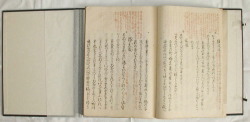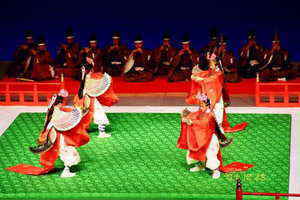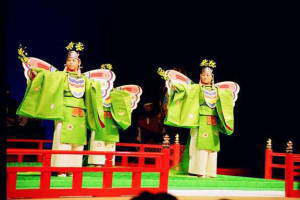The most ancient form of Japanese music
The term Gagaku literally means elegant music, but it also refers to classical music. It is now used in Japan as the generic
name for the most ancient form of Japanese music. Gagaku music was perfected in the 10th century and is based on and influenced
by the music of the countries of ancient Asia.
Gagaku was mostly performed at the Imperial court, in aristocratic society, and at important shrines and temples. There are many
styles and genres of Gagaku, but all of them have a tradition of over a thousand years, and are precious because of their
historical value as the oldest form of musical culture in existence today.
A: Classification of Gagaku by the origins
Gagaku is divided into three categories, according to the origins and locations of each style.- "Kuniburi-no-UtaMai" (native-style songs and dances)
These songs developed into their present form in the 10th century. They are based on the primitive songs of ancient Japan such as Kagura-Uta, Azuma-Asobi, Yamato-Uta, and Kume-Uta. They have also been influenced by the music and dances of Continental Asia. - "Gakumai" of Continental Origin (continental music and dances)
These styles of instrumental music and dances, which were introduced to Japan, are based on those of China, Korea and other countries of Asia. They are classified, according to their origin, into music and dances of the "Left-School" and "Right-School", which differ from each other in the arrangement of the instruments. The music and dances of the Left School, are based on those originating in China, Central Asia and India, and are known as Togaku (Chinese music). The music and dances of the Right School, are based on those originating in Korea and Manchuria (northern China), and are known as Komagaku (Korean music). - "Utamono" (vocal, or recitative pieces)
This is vocal music, composed under the influence of continental Asian music during the Heian Period (794-1192), and is sung with the accompaniment of Chinese instruments. The vocal part of the music is comprised of Saibara whose lyrics come from Japanese folk songs and Roei (recitation) whose words come from Chinese poems.
| Background - Lyrics & Notes | ||
 |
 |
 |
| Kagura/Saibara Ryojin-Guan-Sho (An annotated edition of Kagura & Saibara) |
Front Cover of Kagura | Notes for Sho (above) Notes for Hichiriki (below) |
B: Classification of Gagaku by the performance forms
Gagaku is divided into three forms according to the manner in which they are performed. The forms are Kangen (wind and strings), Bugaku (dance and music), and Kayo (songs and recitations).- "Kangen" (wind and strings)
Kangen is performed only with instruments. It uses three kinds of wind instruments such as the Sho, Hichiriki and Ryuteki, two kinds of string instruments such as the Biwa and the So, and three kinds of percussion instruments such as the Kakko, Taiko and Shoko. In Kangen, the wind instruments play the main part of the music. For example the Hichiriki plays the theme, the Ryuteki plays the same, but more ornamentally and the Sho plays the chords. The string and percussion instruments are used mostly for rhythm. In this form of performance, the instruments are played slowly and delicately, contrary to the next form, Bugaku, where they are played vigorously. - "Bugaku" (danse and music)
In this form of Gagaku, dances are performed with musical accompaniment. The dances are divided into three types, for example the dance Sa-no-Mai is accompanied by a Togaku, the dance U-no-Mai is generally accompanied by a Komagaku and the dance Kuniburi-no-Mai (native-style) is accompanied by songs.
- In Sa-no-Mai, or the Left-School dances, costumes of red or similar colors are used. Wind and percussion instruments play the accompaniment, and as a rule, string instruments are not used. The dancers dance to the rhythm of the percussion instruments.
- In U-no-Mai, or the Right-School dances, costumes of green or similar colors are used. Wind and percussion instruments play the accompaniment, and string instruments are never used. The dancers dance to the rhythm of the percussion instruments.
- Kuniburi-no-Mai (native-style dances) are elegant and dignified, though the costumes and dances are plain and simple. Both Japanese and foreign instruments accompany the songs.
- "Kayo" (song and recitations)
The Kayo form of Gagaku uses Kuniburi-no-Uta, Saibara and Roei. Foreign instruments such as the Hichiriki, Ryuteki, and Komabue are used and Japanese instruments such as the Wagon and Kagurabue all accompany the Kuniburi-no-Uta (native-style songs).
- Kuniburi-no-Uta are sung in an unhurried and graceful manner to the beating of a Shaku-Byoshi.
- Saibara is a form of singing accompanied by three wind and two string instruments. The songs are popular Japanese folk songs and are sung rhythmically to the beating of a Shaku-Byoshi.
- In Roei (recitation), the accompaniment is played by only three wind instruments, and elegant Chinese poems are recited using Japanese pronunciation without rhythm. In all these forms of Kayo (vocal music), the songs are sung solo at the begining of the stanza and thereafter in unison by all members of the chorus. The wind instruments are played only by the principal players. In Kayo a Sho is used to keep time for the singers, while it plays chords when used for Kangen and Bugaku.


